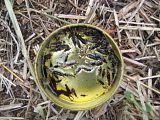People often think that ‘something’ is attacking their plants whereas it might be ‘somethingS’.
My spring vege garden was attacked by mites – mostly red legged earth mites – i know because i could see them. I sprayed with pyrethrum on several occasions and the mite plagued passed.
At this time I finally cleaned up the grass from the adjoining 1 acre paddock and suddenly the mice, slugs, snails, millipedes and earwigs had nowhere to hide. So in they came. All four pests attacked the young seedlings in unison. The following morning the beans, carrots and celery were totally bereft of leaves.
The good news is the carrots and celery have survived. They simply kept on growing new leaves and the pests either gave up or were trapped by the pellets and oil traps i spread around. Unfortunately not many beans can out grow the loss.
The moral of the tale is don’t give up – often plants are capable of surviving even though nothing is left but a stalk.



